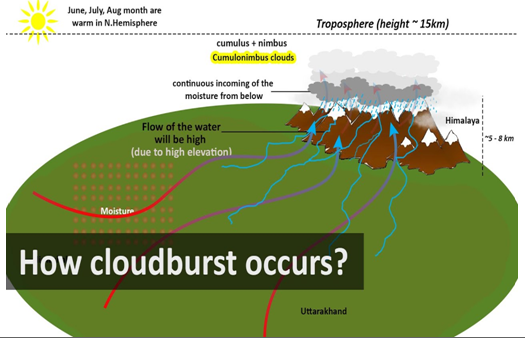

18th August 2025 (15 Topics)
Context:
Five children among seven killed in cloudburst, landslide in Kathua.
Cloudbursts in India: Causes, Consequences, and Preparedness
Definition and Characteristics
- Nature of Event: A cloudburst is a sudden and highly intense rainfall event (?100 mm/hour over 20–30 km²).
- Cloud Source: Typically originates in cumulonimbus clouds between 1000–2500 m altitude under unstable, moisture-rich conditions.
- Langmuir Effect: Raindrops grow through coalescence until gravitational pull overcomes updrafts, leading to a sudden downpour.
Climatological and Geophysical Mechanisms
- Orographic Uplift: Moist air is forced upwards by hills, condensing rapidly into dense clouds.
- Airmass Convergence: Interaction of monsoon winds with dry air enhances vertical uplift.
- Instability and Low Pressure: Sudden temperature/pressure changes and regional depressions accelerate condensation.
- High Humidity and Lightning Delay: Excess moisture retention within clouds magnifies precipitation intensity.
Cloudburst-Prone Regions in India
- Himalayan States: Jammu & Kashmir, Himachal Pradesh, Uttarakhand, Sikkim.
- North-East India: Arunachal Pradesh, Meghalaya, Nagaland.
- Western Ghats: Kerala and Karnataka occasionally report such events.
Recent Examples
- Cloudburst-triggered Flash Flood in Chositi, Kishtwar (August 2025)
- Uttarkashi Flash Floods Following Cloudburst (5 August 2025)
- Mandi, Himachal Pradesh (July–August 2025)
- Himachal Pradesh (Kullu, August 2023)
- Uttarakhand (Rudraprayag, July 2023)
- Amarnath Yatra (J&K, July 2022)
- Ladakh (Leh, August 2010)
Hazards Associated with Cloudbursts
- Flash Floods: Torrents sweep away settlements, roads, and bridges in valleys.
- Landslides and Mudflows: Water-saturated slopes collapse, generating destructive slurry flows.
- Ground Subsidence: Excess pressure leads to sinkholes and hillside collapses.
- River System Impact: Riverbank erosion, course shifts, and temporary landslide lakes increase downstream flood risks.
Climate Change and Increasing Cloudburst Frequency
- Enhanced Atmospheric Moisture: Warmer air holds more water vapour, causing intense rainfall.
- Erratic Monsoon Patterns: Shorter, more intense rainfall episodes replace steady monsoon rains.
- Himalayan Vulnerability: Steep topography, fragile geology, and unplanned construction amplify disaster risks.
NDMA Guidelines on Cloudbursts
- Risk Mapping: GIS-based identification of hazard-prone zones.
- Radar Coverage Expansion: Installation of Doppler radars in vulnerable hill districts.
- Urban Drainage Planning: Design stormwater drains for short-duration high-intensity rainfall.
- Community Preparedness: Conduct mock drills, awareness campaigns, and early warning dissemination via SMS and sirens.
- Construction Regulation: Enforce slope-based building controls through micro-zoning techniques.
Way Forward
- Improved Prediction Systems: Adoption of high-resolution weather models and AI-based forecasting for localised rainfall.
- Strengthened Early Warning Mechanisms: Real-time monitoring networks in Himalayan States with siren/satellite-based alerts.
- Eco-sensitive Infrastructure: Restriction of construction in fragile slope zones, mandatory slope-stabilisation measures, and watershed management.
- Reforestation and Land Use Regulation: Afforestation to stabilise slopes and better land regulation to prevent unplanned expansion.
- Community Resilience: Training locals in evacuation, first aid, and relief operations to minimise casualties.
More Articles


